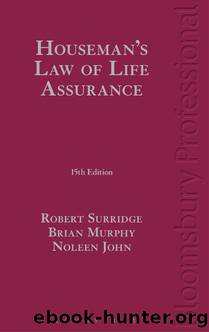Houseman's Law of Life Assurance by Surridge Robert;John Noleen;Murphy Brian;

Author:Surridge, Robert;John, Noleen;Murphy, Brian;
Language: eng
Format: epub
Publisher: Bloomsbury Publishing Plc
Published: 2016-08-15T00:00:00+00:00
BRing-fenced funds
7.50Although the vast majority of reserves (ie representing the excess of assets over liabilities) will be categorised as tier 1 basic own funds, the use of some assets, (ie those in ring-fenced funds and matching adjustment portfolios), may be restricted. The directive61 provides for delegated acts to specify the adjustments to be made to reflect the fact that the assets in ring-fenced funds cannot be made available outside of the ring-fenced funds. The adjustment to be made to tier 1 assets (ie the reconciliation reserve) is effectively the amount by which assets in the fund exceed the notional SCR for the fund62 required by Article 216 of the Solvency II.
The directive does not provide a clear definition of what constitutes a ring-fenced fund. Article 99 is arguably the closest thing to a definition in the directive of ring-fenced funds. It states the following (emphasis added):
âthe adjustments that should be made to reflect the lack of transferability of those own-fund items that can be used only to cover losses arising from a particular segment of liabilities or from particular risks (ring-fenced funds).â
Similarly, Article 80 of the Solvency II Regulation requires the deduction (ie of the amount of excess above the notional SCR) where own-fund items within a ring-fenced fund or matching adjustment portfolio have a reduced capacity to fully absorb losses on a going-concern basis due to their lack of transferability within the insurance undertaking. The lack of transferability, which therefore appears to define the concept of a ring-fenced fund, is stated to be as follows:
(a)the items can only be used to cover losses on a defined portion of the insurerâs insurance or reinsurance contracts;
(b)the items can only be used to cover losses in respect of certain policyholders or beneficiaries;
(c)the items can only be used to cover losses arising from particular risks or liabilities.
It should also be noted that Article 80 refers to capacity to absorb losses on a going concern basis. The position initially adopted during the implementation process was that the ring-fencing had to exist on a winding up as well as a going concern basis. This latter concept appears to have been dropped (see paragraph 1.4 of EIOPA Guidelines on ring-fenced funds)63. These guidelines also confirm that conventional unit-linked products are not ring-fenced funds (see paragraph 1.10) and that the Guidelines (other than Guidelines 1-5) also apply in relation to matching adjustment portfolios (see Guideline 1.5). In the UK, COBS 20.1 makes clear that UK with-profits fund and sub-funds will be treated as separate ring-fenced funds where they were treated as separate with-profits funds prior to 1 January 2016. Although, as stated above, surplus funds can exist in a with-profits fund (eg future discretionary benefits), because of the FCA Rules, surplus funds in a with-profit fund may be restricted items and only be available to meet the requirements of the particular ring-fenced with profits fund (see 6.14 and 6.16).
Another issue which has arisen relates to collateralised reinsurance obligations and whether provision of collateral means that such assets are restricted.
Download
This site does not store any files on its server. We only index and link to content provided by other sites. Please contact the content providers to delete copyright contents if any and email us, we'll remove relevant links or contents immediately.
The Social Psychology of Inequality by Unknown(2312)
The Plant Paradox by Dr. Steven R. Gundry M.D(2043)
The Writing on the Wall by Anselm Jappe(1759)
Working for Yourself by J.D. (Nolo) Stephen Fishman(1479)
Every Landlord's Legal Guide by Janet Portman & Stewart Marcia & Ralph Warner(1326)
The First 20 Hours: How to Learn Anything ... Fast by Kaufman Josh(1304)
ADHD on Trial by Michael Gordon(1241)
Decisive by Chip Heath(1202)
Drafting Contracts: How and Why Lawyers Do What They Do, Second Edition by Stark Tina L(1174)
Working for Yourself by Stephen Fishman J.D. (Nolo)(1140)
The Economist Aug 8th 2015 by The Economist(1123)
Restitution by Restitution(1116)
The Economist Aug 29th 2015 by The Economist(1098)
A Practical Guide to International Arbitration in London by Hilary Heilbron(1085)
The Lord of the Rings: The Fellowship of the Ring, the Two Towers, the Return of the King by J. R. R. Tolkien(1083)
Intellectual Property Strategy by John Palfrey(1082)
Collusion by Luke Harding(1045)
Persuasion by Owner(1014)
Chapter 1 by Owner(950)
